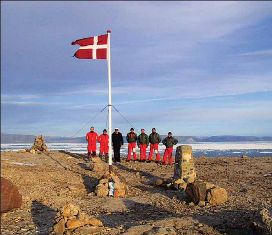
Canada and Denmark aren’t known for being particularly rapacious, war-hungry nations. But neither country is backing down when it comes to the oil, fish, and shipping paths now available thanks to melting icecaps.
The Arctic contains an estimated 25 percent of the world’s undiscovered oil and gas supply. Which is why both Canada and Denmark have planted their flags (literally) on the barren, 1/2 sq mile rock called Hans Island. Besides being near potential oceanic drill sites, Hans Island is conveniently located at the mouth to the Northwest Passage, an increasingly iceless Arctic channel that would make freight shipping from Europe to Alaska 60 percent faster than through the Panama Canal.
Americans are also getting in on the land rush: OmniTrax, a US shipping company, bought the northern Manitoba Port of Churchill, for $10 Canadian. It’s already pushed 500,000 tons of grain through the tiny harbor.
This is all good and fine for capitalism, but environmentalists are not so happy. The more oil tankers use Arctic shipping lanes like the Northwest Passage, the greater the chance of oil spills. And as Arctic traffic increases, there are more chances of non-native species jumping ship and colonizing the newly warm waters and lands.
Plus there’s the fact that, well, people already live there. These peoples, with their long-standing traditions and customs, might just have something to say about other nations rushing to drill their land for oil, or plunging cargo ships through their waters.
One is reminded of British and Dutch colonists ignoring native people’s rights, territories, and resources in their rush to reap the booty of a “new” and “uncivilized” land. Will Americans, Danes, and Canadians do the same thing?
—Jen Phillips















